Metrology Benchmarking of 3D Scanning Sensors Using a Ceramic GD&T-Based Artefact
Abstract
:1. Introduction
2. Materials and Methods
2.1. The Concept of the Ceramic GD&T Master Gauge for Metrological Evaluation
- Distance between spheres, between cylinders, and between parallel planes; the distance between the (parallel) cylinders was evaluated between their axes and the distance between the parallel planes was evaluated as the distance from the centroid perpendicular to the reference plane;
- Diameters of spheres and cylinders;
- Form error of spheres, planes, cylinders, and cones;
- Angle of inclination of planes and angle of cones, with respect to the plane XY;
- Parallelism between cylinders, between cones, and between planes;
- Perpendicularity between planes;
- Coaxiality between cylinders.
2.2. Gauge Manufacturing and Datum/Reference Measurements
2.3. Non-Contact Scanning Sensors
2.4. The Comparison Methodology
3. Experimental Procedure
3.1. Measurement of the GD&T Artefact by Contact Probing in the CMM: The Reference Measurement Values
3.2. Measurement of the GD&T Artefact with Non-Contact Scanning Sensors
3.2.1. Laser Triangulation Sensor Mounted on the CMM (LS-CMM)
3.2.2. Laser Triangulation Sensor Mounted on a Coordinate Measuring Arm (LS-CMA)
3.2.3. Handheld Laser Triangulation Sensor (HLS)
3.2.4. Structured Light 3D Optical Scanner (SL)
3.3. Postprocessing of the Raw Pointclouds (Filters)
- Reconstruction of the feature from the unfiltered point cloud;
- Calculation of the standard deviation of the fit (point cloud to feature);
- Setting of the filter distance: multiplication of the standard deviation by a factor (1, 2, 3);
- Filtering the point cloud, removing points located at a distance superior to the previous value;
- Reconstruction of the feature from the filtered point cloud.
4. Results
4.1. Dimensional Analysis
4.2. Form Deviations
4.3. Standard Deviations in Point Clouds
4.4. Determination of the Uncertainty of Measurements
5. Comparison and Discussion of Results
6. Conclusions
Author Contributions
Funding
Institutional Review Board Statement
Informed Consent Statement
Data Availability Statement
Acknowledgments
Conflicts of Interest
References
- Carmignato, S.; De Chiffre, L.; Bosse, H.; Leach, R.K.; Balsamo, A.; Estler, W.T. Dimensional artefacts to achieve metrological traceability in advanced manufacturing. CIRP Ann.-Manuf. Technol. 2020, 69, 693716. [Google Scholar] [CrossRef]
- ASTM E2544-11a; Standard Terminology for Three-Dimensional (3D) Imaging Systems. ASTM: West Conshohocken, PA, USA, 2011. [CrossRef]
- Carmignato, S.; Savio, E. Metrological performance verification of coordinate measuring systems with optical distance sensors. Int. J. Precis Technol. 2011, 2, 153–171. [Google Scholar] [CrossRef]
- Guerra, M.G.; Lavecchia, F.; Maggipinto, G.; Galantuccia, L.M.; Longo, G.A. Measuring techniques suitable for verification and repairing of industrial components: A comparison among optical systems. CIRP J. Manuf. Sci. Technol. 2019, 27, 114–123. [Google Scholar] [CrossRef]
- Iuliano, L.; Minetola, P. Rapid Manufacturing of sculptures replicas: A comparison between 3D optical scanners. In Proceedings of the CIPA XX International Symposium, Torino, Italy, 26 September 2005. [Google Scholar]
- Piratelli-Filho, A.; Jobim Souza, P.H.; Valdés Arencibia, R.; Anwer, N. Study of Contact and Non-contact Measurement Techniques Applied to Reverse Engineering of Complex Freeform Parts. Int. J. Mech. Eng. Autom. 2014, 1, 166–175. [Google Scholar]
- Isheil, A.; Gonnet, J.-P.; Joannic, D.; Fontaine, J.-F. Systematic error correction of a 3D laser scanning measurement device. Opt. Lasers Eng. 2011, 49, 16–24. [Google Scholar] [CrossRef]
- Bešić, I.; Van Gestel, N.; Kruth, J.P.; Bleys, P.; Hodolič, J. Accuracy improvement of laser line scanning for feature measurements on CMM. Opt. Lasers Eng. 2011, 49, 1274–1280. [Google Scholar] [CrossRef]
- Cuesta, E.; Álvarez, B.J.; Martínez-Pellitero, S.; Barreiro, J.; Patiño, H. Metrological evaluation of laser scanner integrated with measuring arm using optical feature-based gauge. Opt. Lasers Eng. 2019, 121, 120–132. [Google Scholar] [CrossRef]
- Mendřický, R.; Sobotka, J. Accuracy Comparison of the Optical 3D Scanner and CT Scanner. Manuf. Technol. 2020, 20, 791–801. [Google Scholar] [CrossRef]
- Ramos, B.; Santos, E. Comparative study of different digitization techniques and their accuracy. Comput.-Aided Des. 2011, 43, 188–206. [Google Scholar] [CrossRef]
- Boeckmans, B.; Probst, G.; Zhang, M.; Dewulf, W.; Kruth, J.P. ISO 10360 verification test applied to CMMs equipped with a laser line scanner. In Proceedings of the SPIE Dimensional Optical Metrology and Inspection for Practical Applications V, Baltimore, MA, USA, 19 May 2016. [Google Scholar] [CrossRef]
- ISO 15530-3; Geometrical Product Specifications (GPS)—Coordinate Measuring Machines (CMM): Technique for Determining the Uncertainty of Measurement—Part 3: Use of Calibrated Workpieces or Measurement Standards. International Organization for Standardization: Geneva, Switzerland, 2011.
- VDI/VDE 2634-2; Optical 3D Measuring Systems: Optical Systems Based on Area Scanning. VDI: Beuth/Berlin, Germany, 2012.
- VDI/VDE 2634-3; Optical 3D Measuring Systems: Multiple View Systems Based on Area Scanning. VDI: Beuth/Berlin, Germany, 2008.
- ISO 10360-8; Geometrical Product Specifications (GPS)—Acceptance and Reverification Tests for Coordinate Measuring Systems (CMS)—Part 8: CMMs with Optical Distance Sensors. International Organization for Standardization: Geneva, Switzerland, 2013.
- ISO 10360-13; Geometrical Product Specifications (GPS)—Acceptance and Reverification Tests for Coordinate Measuring Systems (CMS)—Part 13: Optical 3D CMS. International Organization for Standardization: Geneva, Switzerland, 2021.
- ISO 10360-2; Geometrical Product Specifications (GPS)—Acceptance and Reverification Tests for Coordinate Measuring Machines (CMM)—Part 2: CMMs Used for Measuring Linear Dimensions. International Organization for Standardization: Geneva, Switzerland, 2009.
- Guidi, G. Metrological characterization of 3D imaging devices. In Proceedings of SPIE—The International Society for Optical Engineering, Munich, Germany, 23 May 2013. [Google Scholar] [CrossRef]
- González-Jorge, H.; Riveiro, B.; Armesto, J.; Arias, P. Standard artifact for the geometric verification of terrestrial laser. Opt. Laser Technol. 2011, 43, 1249–1256. [Google Scholar] [CrossRef]
- Guidi, G.; Russo, M.; Magrassi, G.; Bordegon, M. Performance Evaluation of Triangulation Based Range Sensors. Sensors 2010, 10, 7192–7215. [Google Scholar] [CrossRef] [PubMed]
- Vezzetti, E. Computer aided inspection: Design of customer-oriented benchmark for noncontact 3D scanner evaluation. Int. J. Adv. Manuf. Technol. 2009, 41, 1140–1151. [Google Scholar] [CrossRef] [Green Version]
- Acko, B.; McCarthy, M.; Haertig, F.; Buchmeister, B. Standards for testing freeform measurement capability of optical and tactile coordinate measuring machines. Meas. Sci. Technol. 2012, 23, 094013. [Google Scholar] [CrossRef]
- McCarthy, M.B.; Brown, S.B.; Evenden, A.; Robinson, A.D. NPL freeform artefact for verification of non-contact measuring systems. In Proceedings of the SPIE Three-Dimensional Imaging, Interaction, and Measurement, San Francisco, CA, USA, 27 January 2011. [Google Scholar] [CrossRef]
- Iuliano, L.; Minetola, P. Enhancing moulds manufacturing by means of Reverse Engineering. Int. J. Adv. Manuf. Technol. 2009, 43, 551–562. [Google Scholar] [CrossRef]
- Iuliano, L.; Minetola, P.; Salmi, A. Proposal of an Innovative Benchmark for Comparison of the Performance of Contactless Digitizers. Meas. Sci. Technol. 2010, 21, 105102. [Google Scholar] [CrossRef]
- MacKinnon, D.; Carrier, B.; Beraldin, J.A.; Cournoyer, L. GD&T-Based Characterization of Short-Range Noncontact 3D Imaging Systems. Int. J. Comput. Vis. 2013, 102, 56–72. [Google Scholar] [CrossRef]
- Beraldin, J.A.; Carrier, B.; MacKinnon, D.; Cournoyer, L. Characterization of triangulation-Based 3D Imaging Systems Using Certified Artifacts. NCSLI Meas. 2012, 7, 50–60. [Google Scholar] [CrossRef]
- Carrier, B.; MacKinnon, D.K.; Cournoyer, L. Performance evaluation of 3D imaging systems based on GD&T. Manuf. Lett. 2013, 1, 9–12. [Google Scholar] [CrossRef] [Green Version]
- Carrier, B.; MacKinnon, D.K.; Cournoyer, L.; Beraldin, J.A. Proposed NRC portable target case for short-range triangulation-based 3-D imaging systems characterization. In Proceedings of the SPIE Three-Dimensional Imaging, Interaction, and Measurement, San Francisco, CA, USA, 27 January 2011. [Google Scholar] [CrossRef]
- Beraldin, J.A.; Mackinnon, D.; Cournoyer, L. Metrological characterization of 3D imaging systems: Progress report on standards developments. In Proceedings of the 17th International Congress Metrology, Paris, France, 21 September 2015. [Google Scholar] [CrossRef]
- Dury, M.R.; McCarthy, M.B.; Brown, S.B.; Woodward, S. Surface Finish and 3D Optical Scanner Measurement Performance for Precision Engineering. In Proceedings of the 30th Annual Meeting of the American Society for Precision Engineering, Austin, TX, USA, 1 November 2015. [Google Scholar]
- Dury, M.R.; Woodward, S.; Brown, S.B.; McCarthy, M.B. Characterising 3D optical scanner measurement performance for precision engineering. In Proceedings of the 31st Annual Meeting of the American Society for Precision Engineering, Portland, OR, USA, 23 October 2016. [Google Scholar]
- Hodgson, J.R.; Kinnell, P.; Justham, L.; Lohse, N.; Jackson, M.R. Novel metrics and methodology for the characterisation of 3D imaging systems. Opt. Laser Eng. 2017, 91, 169–177. [Google Scholar] [CrossRef] [Green Version]
- Mendřický, R. Determination of Measurement Accuracy of Optical 3D Scanners. MM Sci. J. 2016, 2016, 1565–1572. [Google Scholar] [CrossRef] [Green Version]
- Mendřický, R. Impact of Applied Anti-Reflective Material on Accuracy of Optical 3D Digitisation. Mater. Sci. Forum 2018, 919, 335–344. [Google Scholar] [CrossRef]
- Palousek, D.; Omasta, M.; Koutny, D.; Bednar, J.; Koutecky, T.; Dokoupil, F. Effect of matte coating on 3D optical measurement accuracy. Opt. Mater. 2015, 40, 1–9. [Google Scholar] [CrossRef]
- Meana, V.; Cuesta, E.; Álvarez, B.J.; Giganto, S.; Martínez-Pellitero, S. Comparison of Chemical and Mechanical Surface Treatments on Metallic Precision Spheres for Using as Optical Reference Artefacts. Materials 2022, 15, 3741. [Google Scholar] [CrossRef] [PubMed]
- MACOR, Ceramic Substrates and Components Ltd. Available online: http://www.corning.com/specialtymaterials/macor (accessed on 15 July 2022).
- Zapico, P.; Álvarez, B.J.; Meana, V.; Telenti, A.; Cuesta, E. Feasibility analysis of using machinable glass ceramics to manufacture non-contact measurement approach metrological artefacts. In IOP Conference Series: Materials Science and Engineering, Proceedings of the 9th Manufacturing Engineering Society International Conference, Gijón, Spain, 23 June 2021. [CrossRef]
- Martínez-Pellitero, S.; Cuesta, E.; Giganto, S.; Barreiro, J. New procedure for qualification of structured light 3D scanners using an optical feature based gauge. Opt. Laser Eng. 2018, 110, 193–206. [Google Scholar] [CrossRef]
- Lu, W.; Liang, J.L.; Ren, M.; Wu, H.; Zhang, J.; Liu, J. Robust and Fast CAD Model Tessellation for Inspection. IEEE Trans. Instrum. Meas. 2022, 71, 1–14. [Google Scholar] [CrossRef]
- Li, B.; Zhang, S. Structured light system calibration method with optimal fringe angle. Appl. Opt. 2014, 53, 7942–7950. [Google Scholar] [CrossRef] [PubMed] [Green Version]
- Hosseininaveh, A.; Sargeant, B.; Erfani, T.; Robson, S.; Shortis, M.; Hess, M.; Boehm, J. Towards fully automatic reliable 3D acquisition: From designing imaging network to a complete and accurate point cloud. Robot. Auton. Syst. 2014, 62, 1197–1207. [Google Scholar] [CrossRef]
- Pathak, V.K.; Singh, A.K. Optimization of morphological process parameters in contactless laser scanning system using modified particle swarm algorithm. Measurement 2017, 109, 27–35. [Google Scholar] [CrossRef]
- ISO 3290-2; Rolling Bearings—Balls—Part 2: Ceramic Balls. International Organization for Standardization: Geneva, Switzerland, 2014.
- EA-4/02 rev 03. Evaluation of the Uncertainty of Measurement in Calibration. EA Laboratory Committee, European Accreditation. 2022. Available online: www.european-accreditation.org (accessed on 21 October 2022).

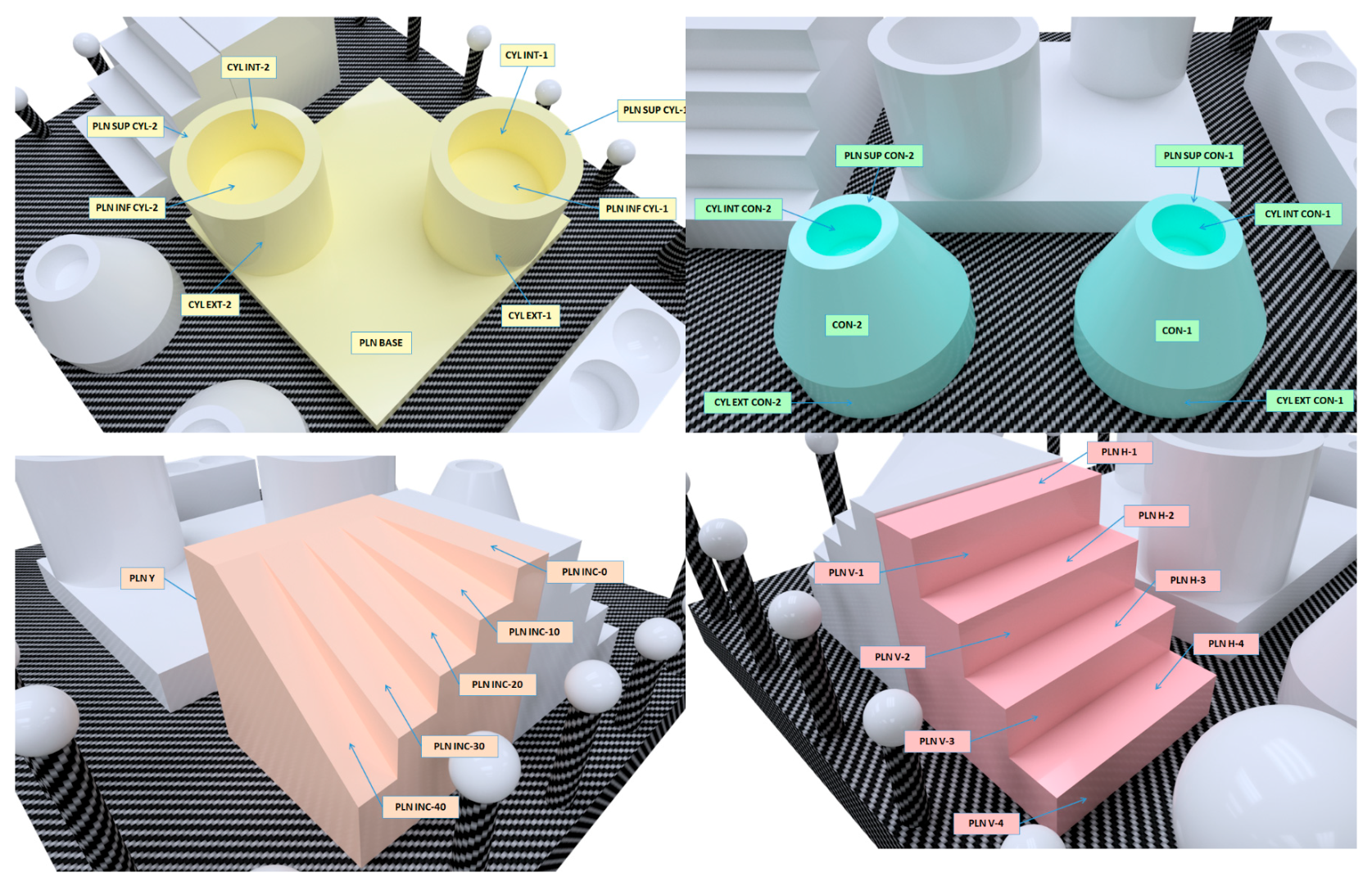

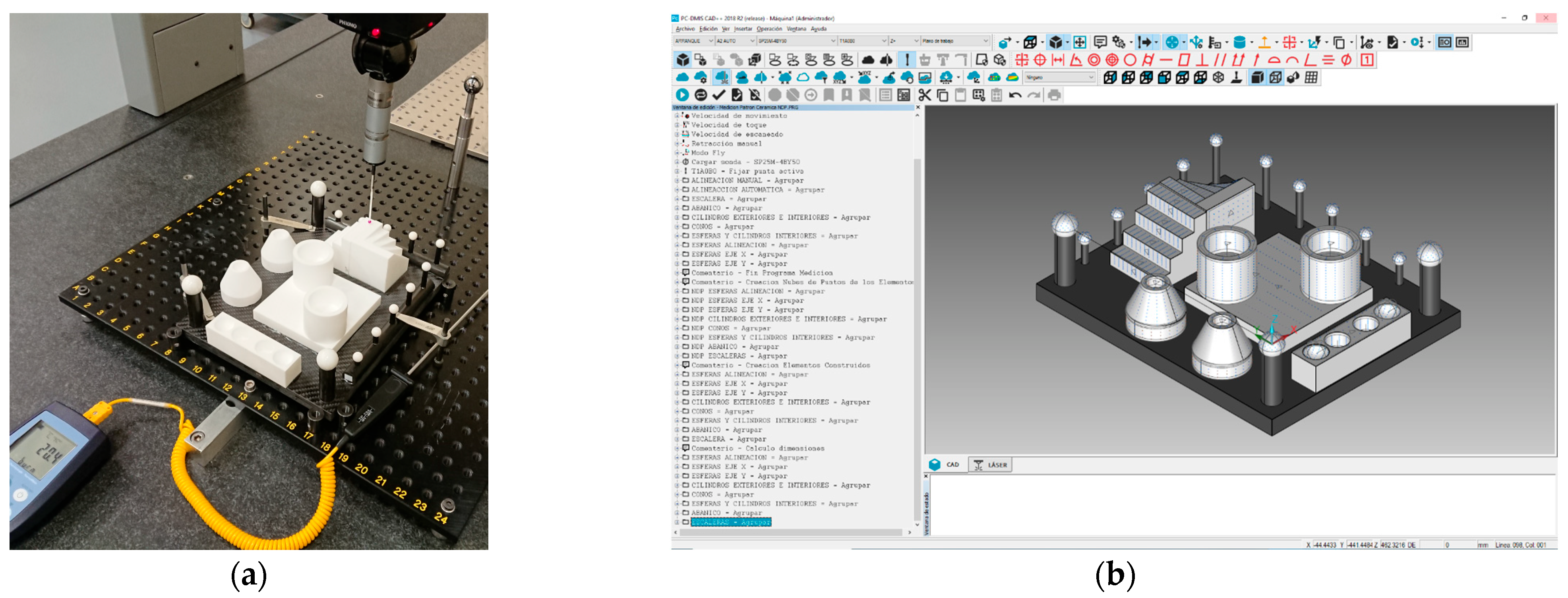
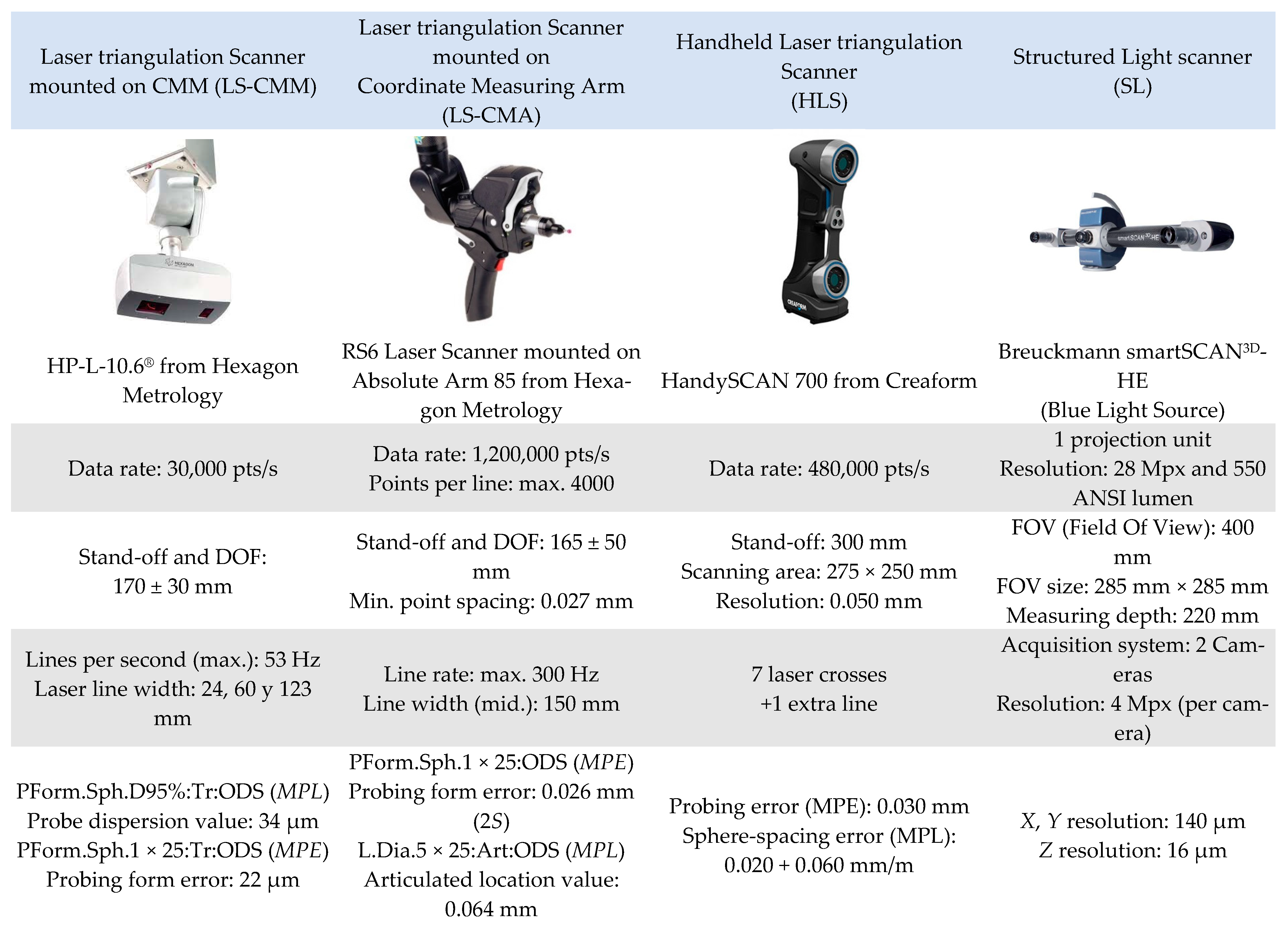

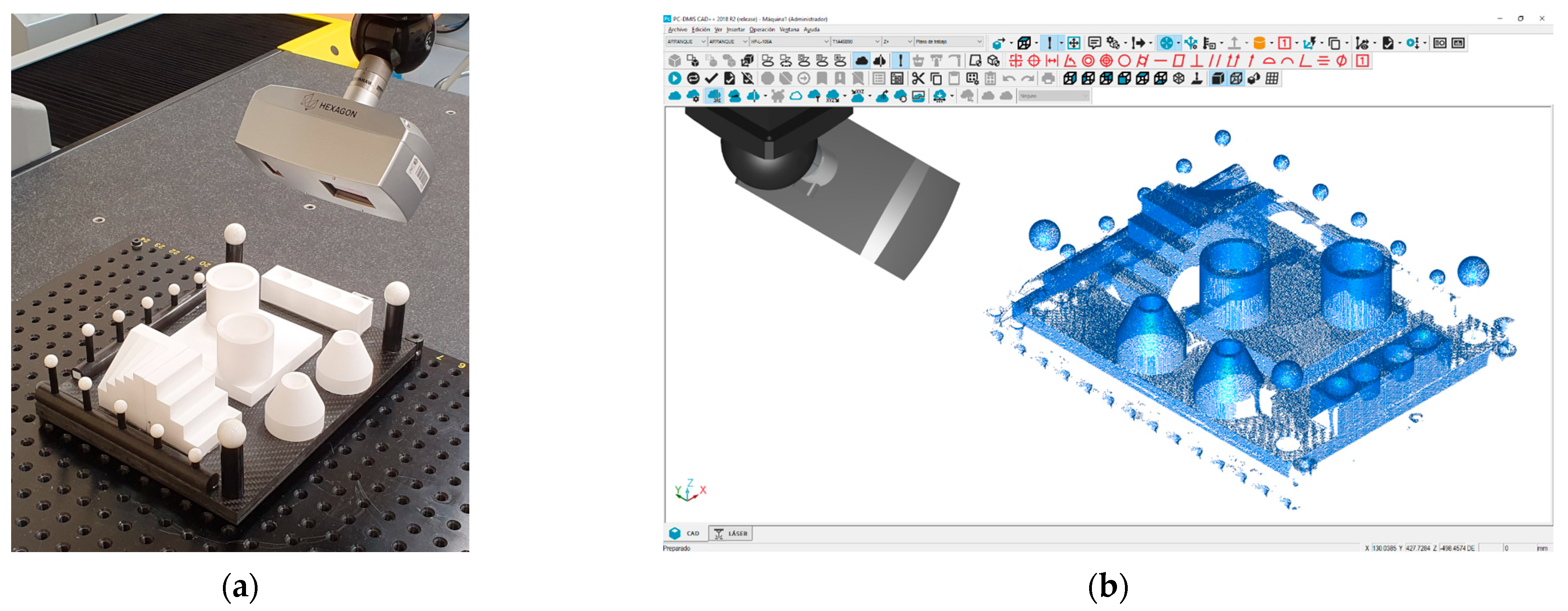




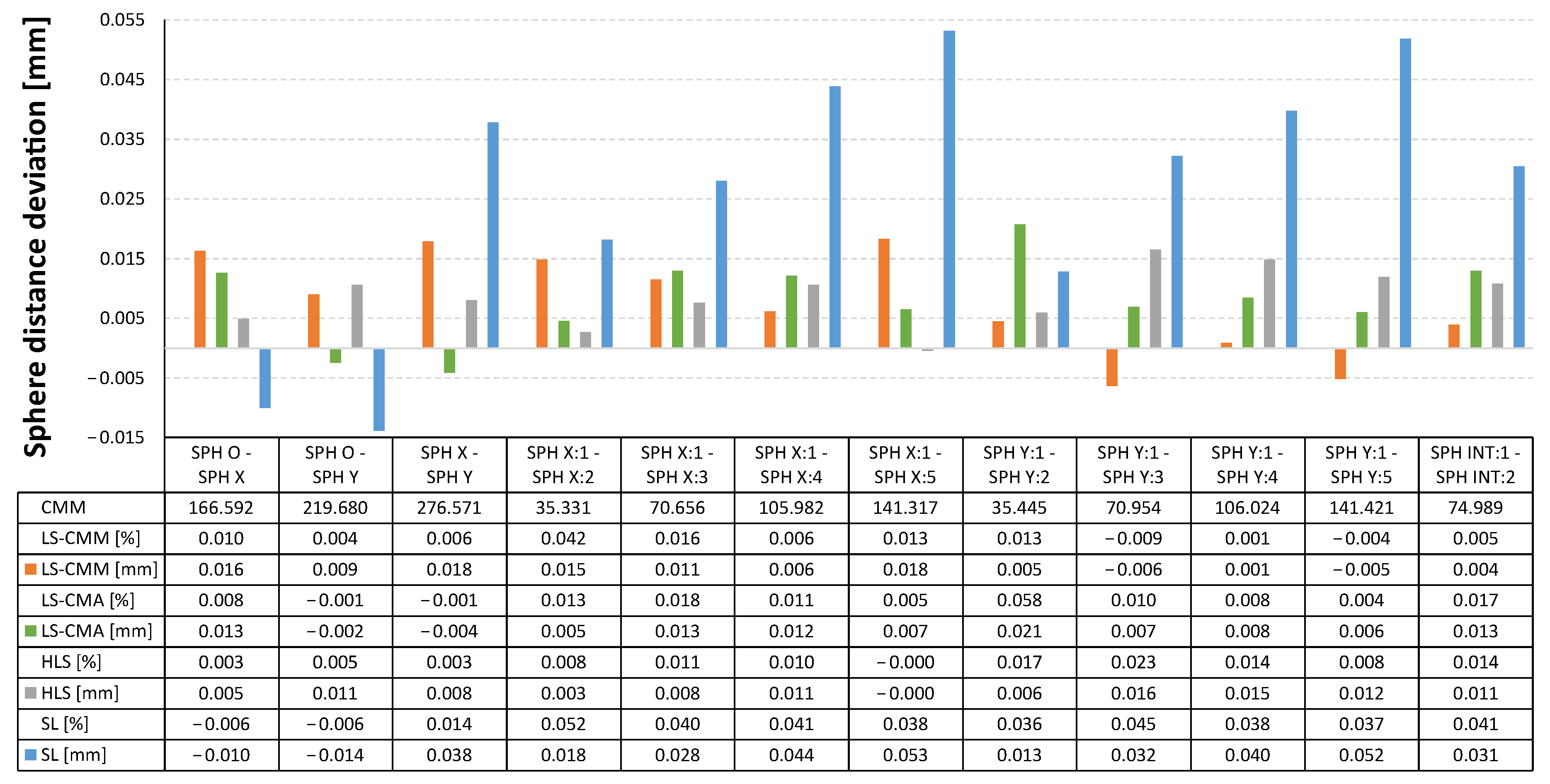
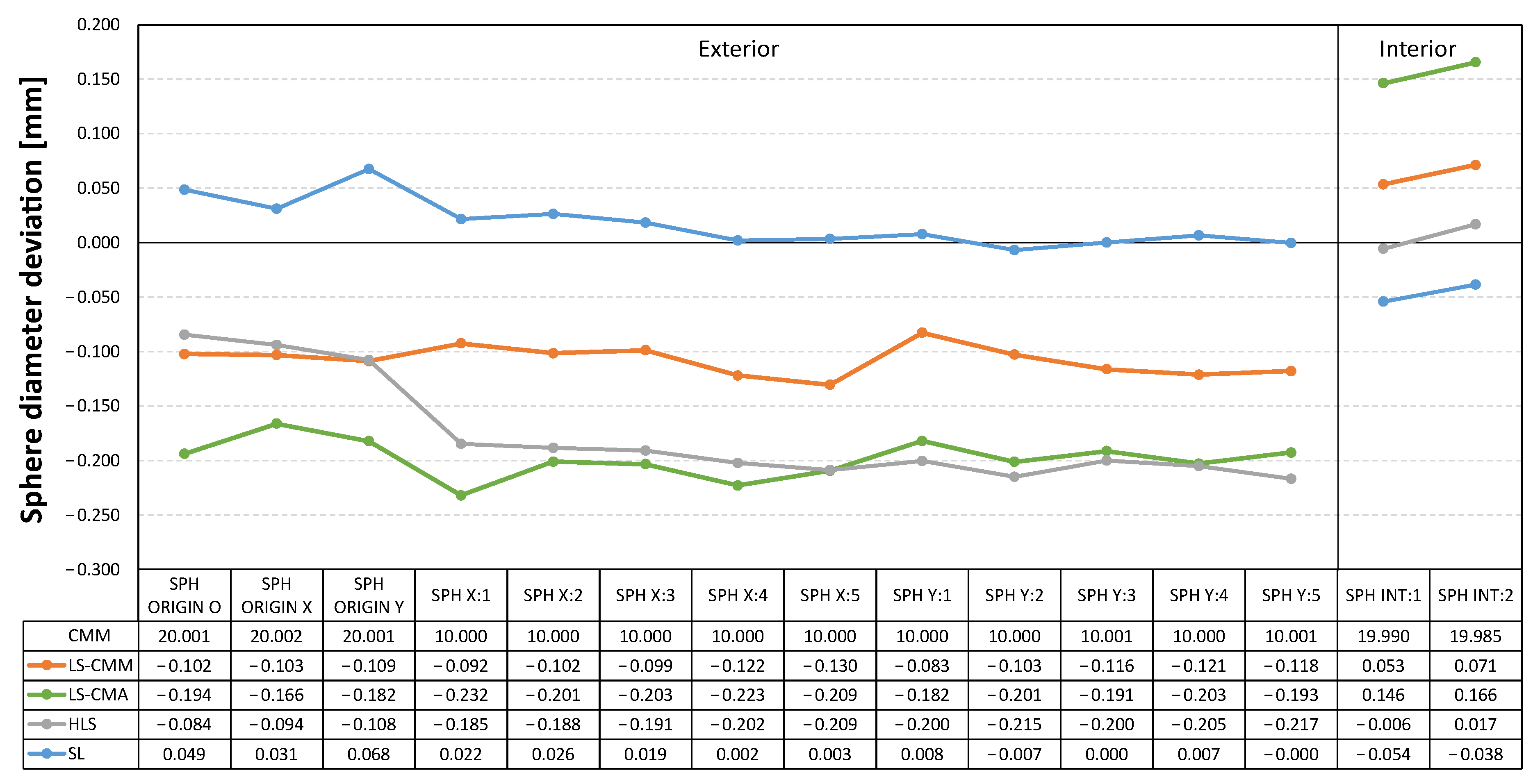
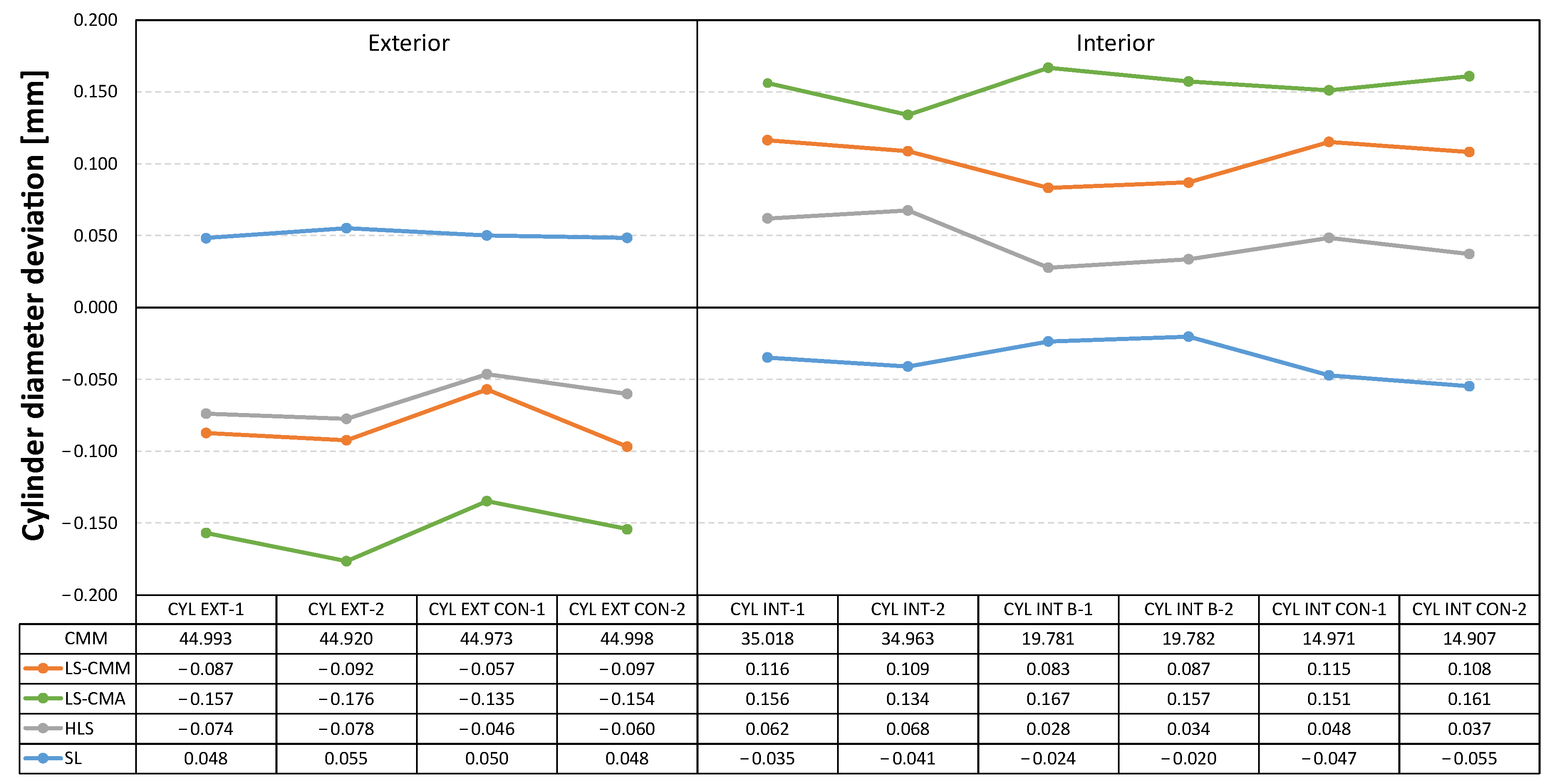


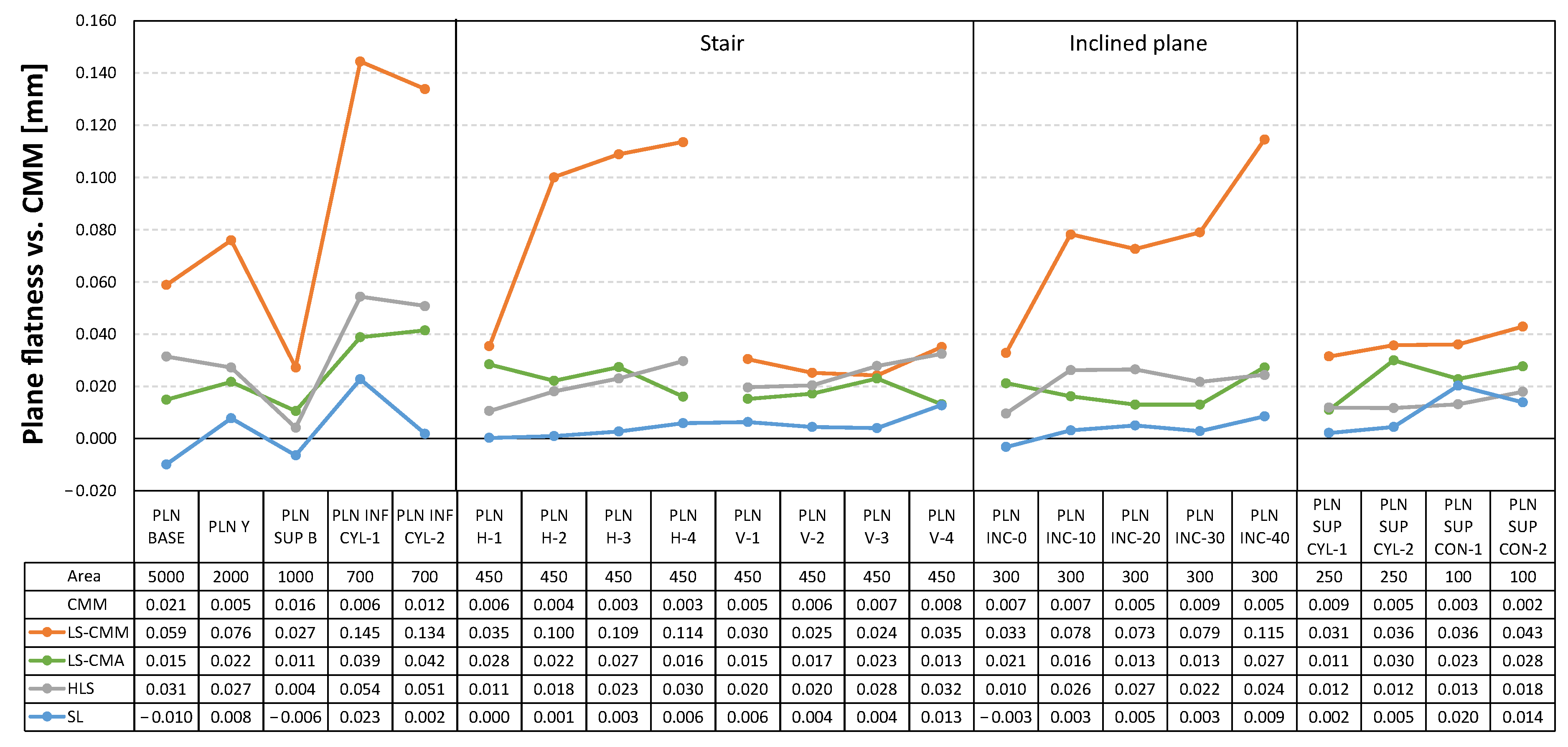
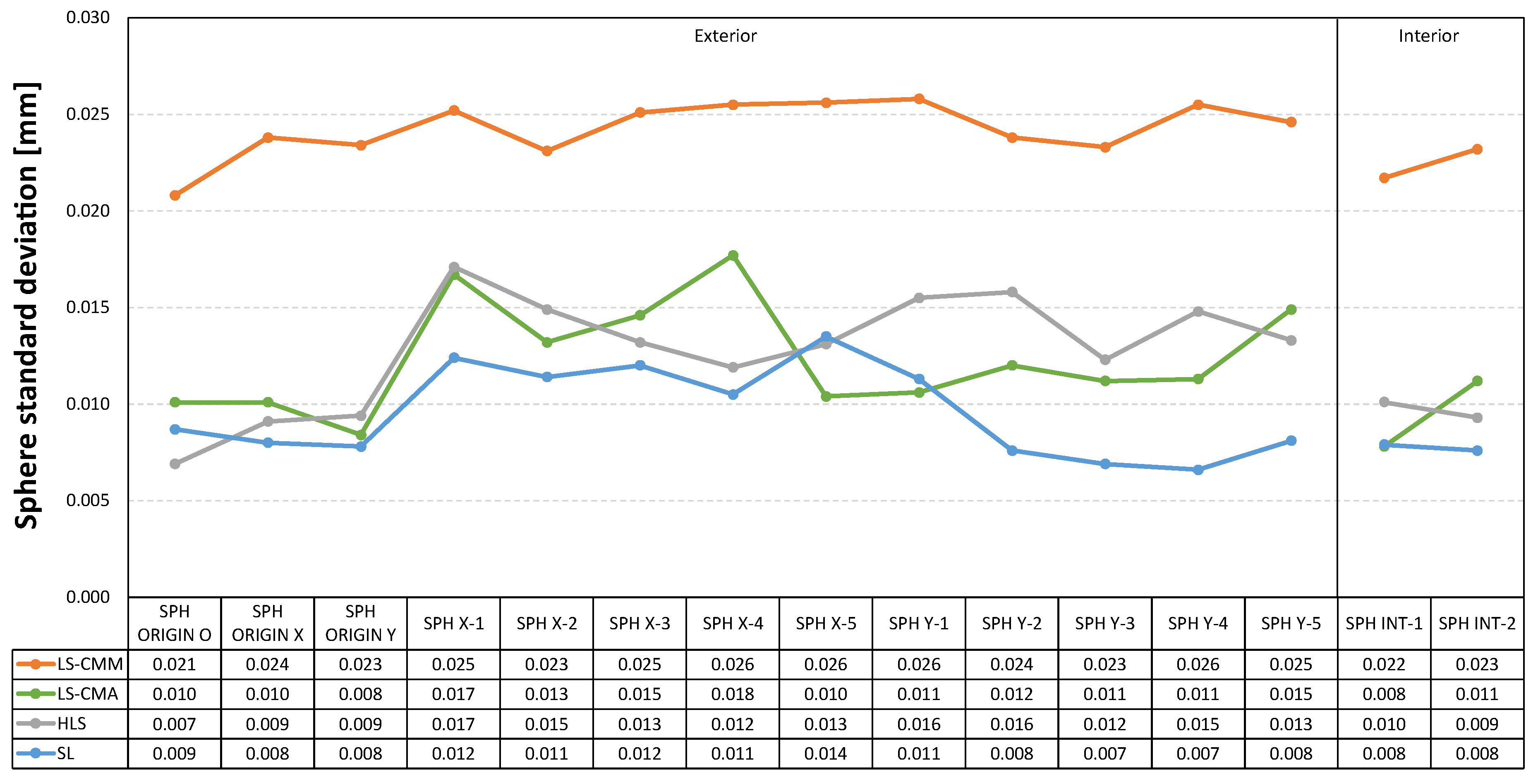
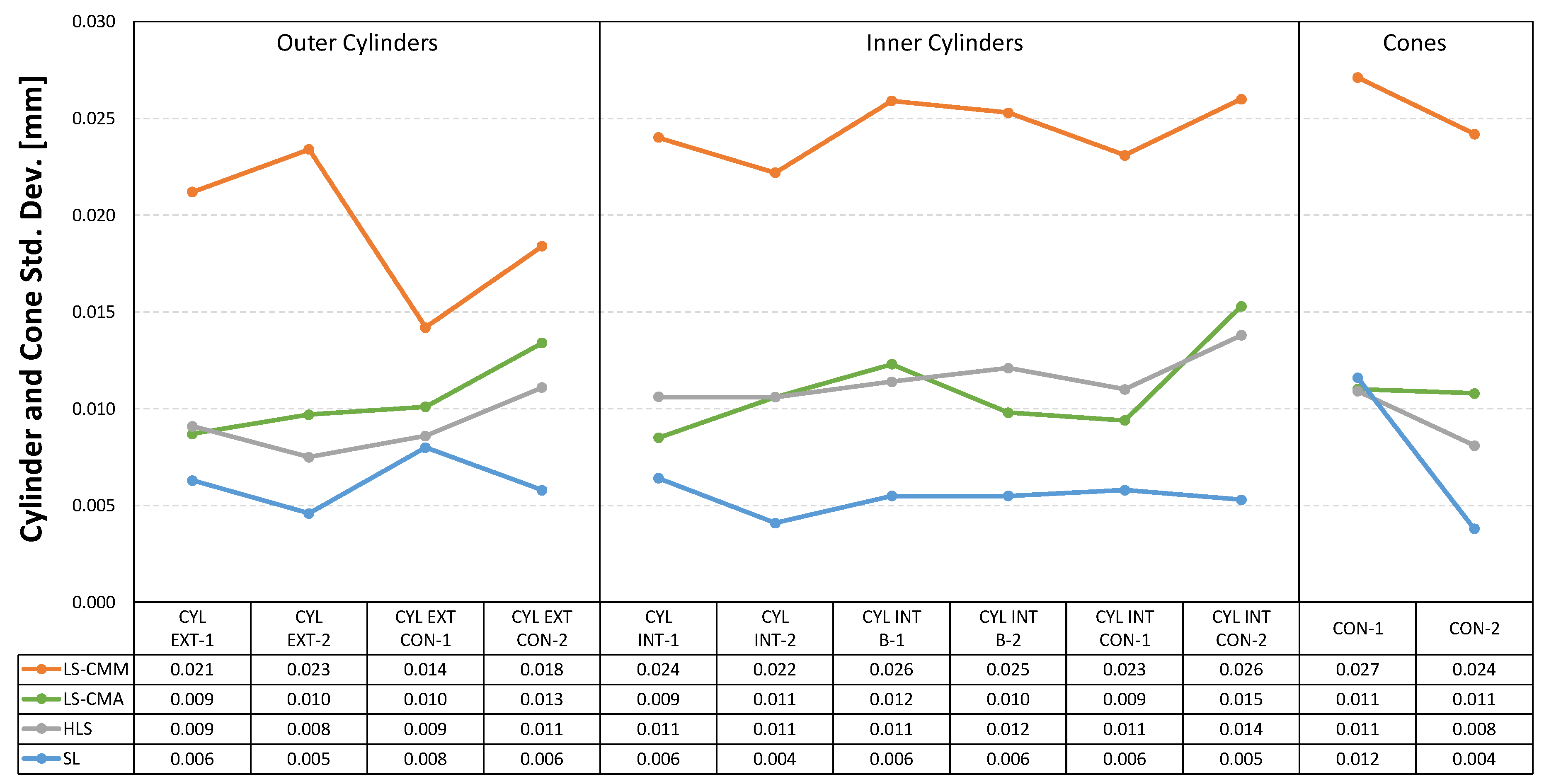
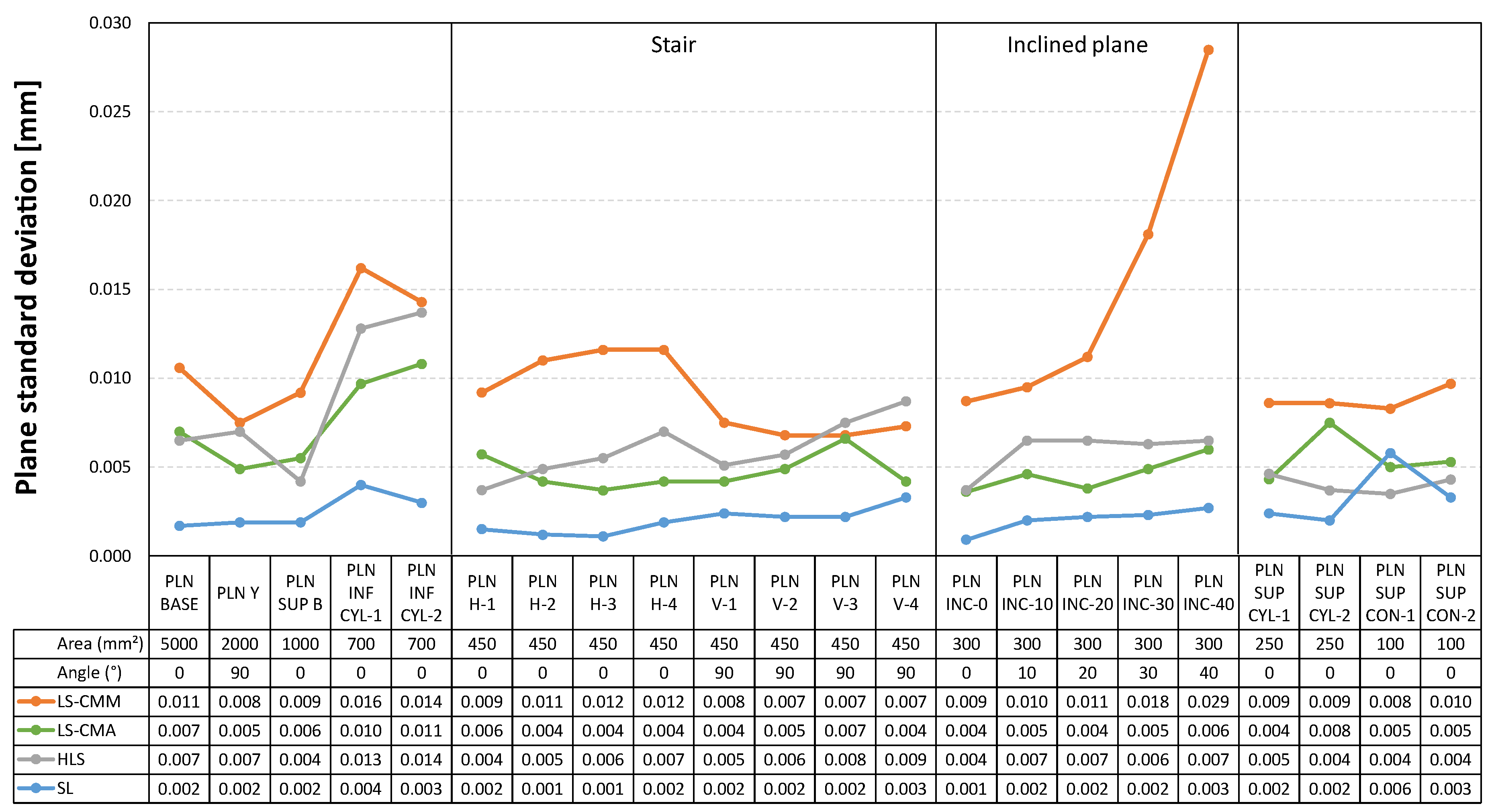
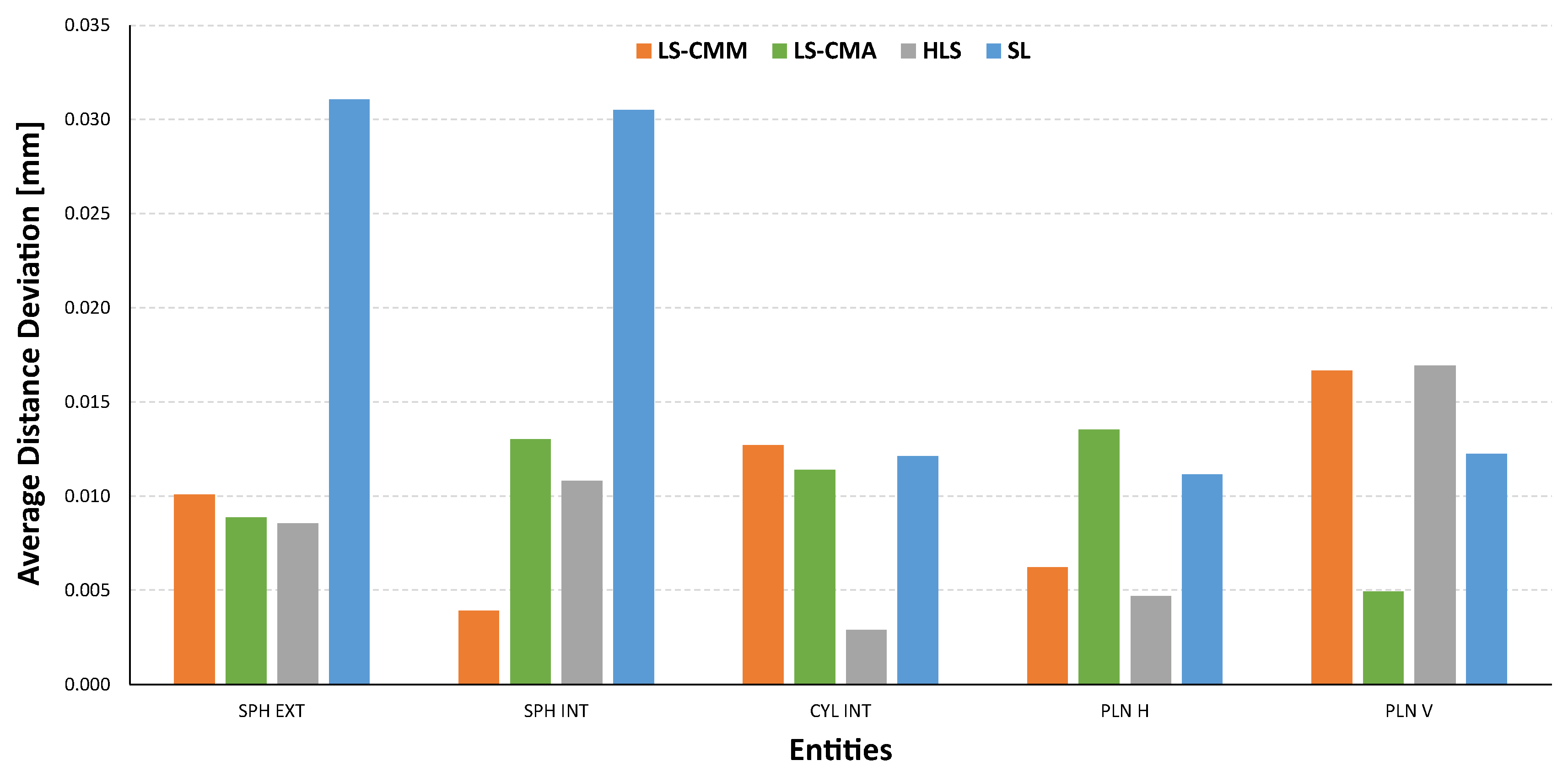

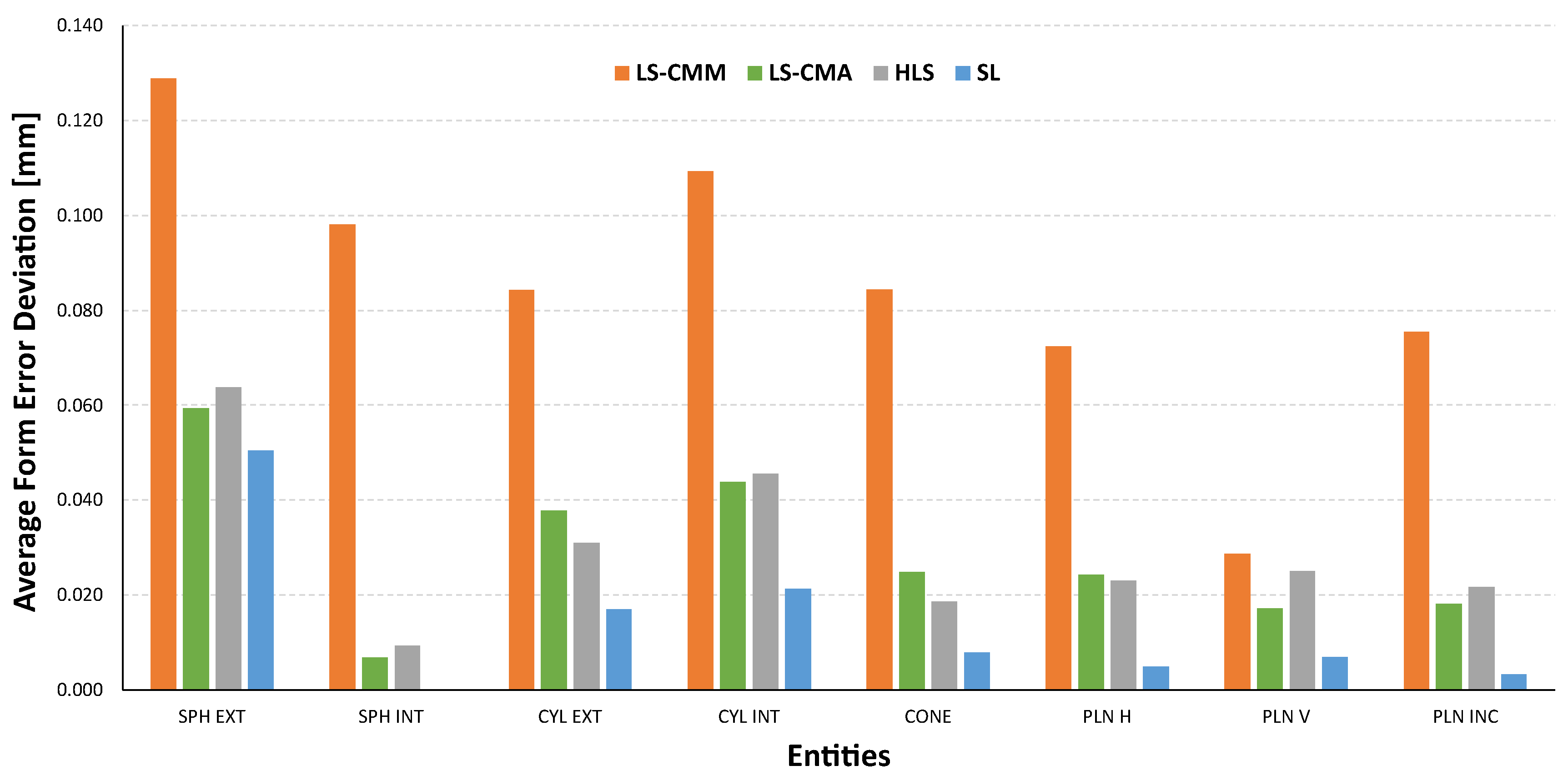
| Contribution | Eval. Type | Distribution | Sensitivity Coef. | Standard Uncertainty | |
|---|---|---|---|---|---|
| Uncertainty of CMM used for calibration | B | Rectangular | |||
| Repeatability of measurements during calibration with CMM | A | Normal | |||
| Reproducibility during calibration with CMM | B | Rectangular | |||
| Combined Standard Uncertainty | |||||
| Coverage Factor | |||||
| Expanded Uncertainty | |||||
| Contribution | Eval. Type | Distribution | Standard Uncertainty | |
|---|---|---|---|---|
| Measurement Repeatability | A | Normal | ||
| Variation of temperature | B | Rectangular | ||
| 3D Sensor Resolution | B | Rectangular | ||
| Artefact calibration | B | Stated in previous calibration | ||
| Expanded uncertainty | ||||
| GD&T Type | GD&T Feature | ||||
|---|---|---|---|---|---|
| Diameters | SPH (external) | 0.0109 | 0.0107 | 0.0086 | 0.0086 |
| CYL EXT | 0.0125 | 0.0120 | 0.0104 | 0.0056 | |
| CYL INT | 0.0105 | 0.0088 | 0.0114 | 0.0099 | |
| Distances | SPH X-Xi & SPH Y-Yi | 0.0078 | 0.0061 | 0.0065 | 0.0109 |
| CYL EXT & CYL INT | 0.0068 | 0.0100 | 0.0059 | 0.0089 | |
| PLN H-Hi &PLN V-Vi | 0.0103 | 0.0087 | 0.0097 | 0.0064 | |
| Form Errors | SPH (all) | 0.0114 | 0.0108 | 0.0114 | 0.0108 |
| CYL EXT & CYL INT | 0.0258 | 0.0092 | 0.0114 | 0.0114 | |
| PLN H & PLN V | 0.0258 | 0.0064 | 0.0068 | 0.0058 | |
| CON EXT & CON INT | 0.0191 | 0.0108 | 0.0125 | 0.0068 | |
| Point clouds Std Dev (Best fit) | SPH (all) | 0.0052 | 0.0054 | 0.0053 | 0.0054 |
| CYL EXT & CYL INT | 0.0057 | 0.0054 | 0.0054 | 0.0053 | |
| PLN H & PLN V | 0.0054 | 0.0052 | 0.0053 | 0.0052 | |
| CON EXT & CON INT | 0.0054 | 0.0052 | 0.0054 | 0.0063 |
Publisher’s Note: MDPI stays neutral with regard to jurisdictional claims in published maps and institutional affiliations. |
© 2022 by the authors. Licensee MDPI, Basel, Switzerland. This article is an open access article distributed under the terms and conditions of the Creative Commons Attribution (CC BY) license (https://creativecommons.org/licenses/by/4.0/).
Share and Cite
Cuesta, E.; Meana, V.; Álvarez, B.J.; Giganto, S.; Martínez-Pellitero, S. Metrology Benchmarking of 3D Scanning Sensors Using a Ceramic GD&T-Based Artefact. Sensors 2022, 22, 8596. https://doi.org/10.3390/s22228596
Cuesta E, Meana V, Álvarez BJ, Giganto S, Martínez-Pellitero S. Metrology Benchmarking of 3D Scanning Sensors Using a Ceramic GD&T-Based Artefact. Sensors. 2022; 22(22):8596. https://doi.org/10.3390/s22228596
Chicago/Turabian StyleCuesta, Eduardo, Víctor Meana, Braulio J. Álvarez, Sara Giganto, and Susana Martínez-Pellitero. 2022. "Metrology Benchmarking of 3D Scanning Sensors Using a Ceramic GD&T-Based Artefact" Sensors 22, no. 22: 8596. https://doi.org/10.3390/s22228596






